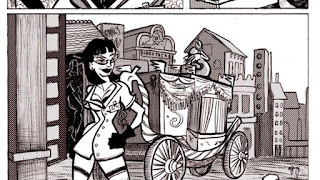Shunga, literally "Images of Spring", is the generic term used to describe erotic prints, books, scrolls and paintings of Japan.
As a dealer of Japanese woodblock prints and shunga in particular I have come across numerous striking and evocative designs. The following 10 shunga designs appeal to me and are in no typical order. These prints I saw in books, on auctions and in private collections.
Kappa Rape - Utamaro
This design is the first print from Utamaro's excellent Uta-makura (Poem of the Pillow) -series published in 1788 and depicts a complex scene with a awabi (abalone) diver watching two kappa(underwater monsters) assaulting a colleague under water. This apparent rape scene is in reality the woman's own fantasie imagining a violent sexual encounter. Also the tightly curled (for the Japanese an expression of high sexual excitement) indicates this is not a rape scene. (Illustrated in Strangers in Paradise - R. Lane on p.14, Ill.131)
Lesbian Couple - Eiri
From Eiri's magnificent Models of Calligraphy published in 1801 an exciting female-female love scene with one of the women (the younger one) wearing a harigata (artificial phallus) and holding a holding a sea shell containing some kind of lubricant. The viewer is struck by the refined beauty reminiscencing the erotic art of ancient Greece. (Illustrated in Japanese Erotic Fantasies - C. Uhlenbeck and M. Winkel on p.147, Ill.49c)
Chinese Couple - Shigenobu
An extraordinary and extreme scene from Shigenobu's Willow Storm-series (late 1820s) involving a Chinese Couple. The man with his plait curled on top of his shaven head is extracting fluid from the woman's vagina. In his book Sex and the Floating World Timon Screech remarks that Keisai Eisen wrote that such fluids were used as an aphrodisiac and rubbed onto the male's genitals before intercourse. (Illustrated in Japanese Erotic Fantasies - C. Uhlenbeck and M. Winkel on p.177, Ill.65b)
Western Couple - Shigenobu
From Shigenobu's same marvellous Willow Storm -series a depiction of a Western couple. What's so unique and striking about this design are the Western influences imitating the shading effects of Western copperplate etching. The Western man is represented as a demon like figure. (Illustrated in Japanese Erotic Fantasies - C. Uhlenbeck and M. Winkel on p.177, Ill.65c)
Tea House - Utamaro
Probably the most acclaimed oban (large format) print within shunga from Utamaro's masterpiece Poem of the Pillow -series depicting two lovers in a private room in a teahouse. The high-quality printing technique, the elegant flowing lines, the composition and the subtle details such as the transparency of the clothing make this one of the most coveted prints. It is whispered that the male lover in this abuna-e (non-explicit print) is actually Utamaro himself. (Illustrated in Japanese Erotic Fantasies - C. Uhlenbeck and M. Winkel on p.130, Ill.39)
Peasant Girl - Kiyonaga
Kiyonaga's Sleeve Scroll (Sode no maki) -series (c.1785) is another highlight of the shunga genre with its unique horizontal hashira-e (pillar print) sized prints. One of the scenes involves a peasant girl and her lover caught in a moment of ecstacy. The girl resting her head on a bundle of charcoal sticks, with her toes curled in sexual bliss. (Illustrated in Vol.24 of The Complete Ukiyo-e Shunga - R. Lane)
Horny Maneemon - Harunobu
The sixth plate in 'The Fashionable Lusty Maneemon' series (c.1770) by Harunobu depicts an intriguing scene in the open air with a peasant girl being taken from behind by a man wearing a mask. Her parents are watching while the man claims he is a descendant of Inari, the god of rice. Maneemon also called 'Miniature Man' or 'Imitation Man' who's the main protagonist in this series is a comic mythical character who sits relaxed under a tree on his straw hat. (Illustrated in Japanese Erotic Prints, Shunga by Harunobu & Koryusai - Inge Klompmakers on p.65)
"69" Position - Hokusai
A scene with a totally nude couple in a soixante-neuf position in a perfectly balanced composition. This print is from Hokusai's most celebrated oban series Fukujuso (The Adonis Plant) and is so distinguishing because of the large scale of the portrayed figures. Some shunga lovers call this image the 'Egg'.
(Illustrated in Vol.23 of The Complete Ukiyo-e Shunga - R. Lane)
Dutchman - Eiri
A striking depicition of a Dutch captain having intercourse with a beautiful courtesan. They are watched (by the viewer) through a window of a Nagasaki brothel. Behind them on a small table an incense burns in a vessel. This specific detail is on a lot of shunga designs depiciting this theme and it is said this use of incense burning by courtesans was to drive away the smell of their Western clients. The long fingernails of the Dutchman are also a striking detail. Dutch women were not allowed to live in Nagasaki but Japanese courtesans were permitted to enter the compounds. Eiri's Models of Calligraphy was inspired by Utamaro's Poem of the Pillow which also includes a Dutch couple. (Illustrated in Vol.24 of The Complete Ukiyo-e Shunga - R. Lane)
Octopus - Hokusai
Last but definitely not least the most famous of all shunga designs best known as The Dream of the Fisherman's Wifefrom Hokusai's Young Pine Saplings (Kinoe no komatsu)-series. A depiction of an abalone diver abandoned in an ecstatic embrace with two octopuses. For a long time collectors and scholars thought this infinitely fascinating scene to be a rape scene but this has been refuted by Danielle Talerico who discovered that an Edo audience would have associated the image with the 日に焼けるまで 田舎の従姉弟と姉と弟 legend of Tamatori. Also the text in the image indicates the mutual satisfaction between all involved protagonists. (Illustrated in numerous books and on countless sites)

কোন মন্তব্য নেই:
একটি মন্তব্য পোস্ট করুন